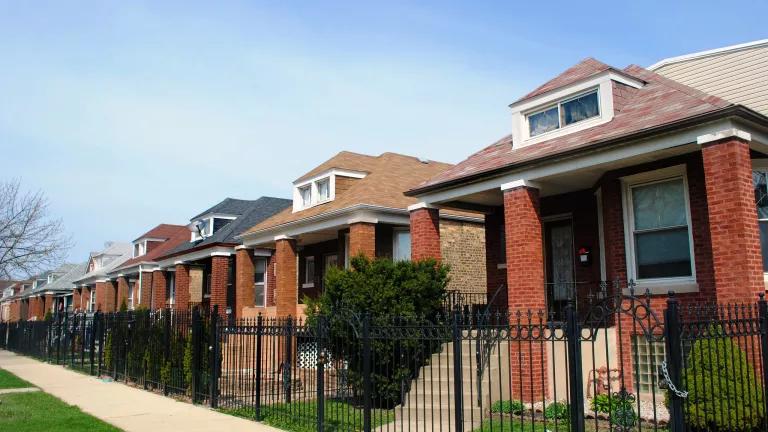Energy Efficiency Leads Climate Fight at Lowest Cost, Impact

This is part of a series of blogs on NRDC’s new report, “America’s Clean Energy Frontier: The Pathway to a Safer Climate Future”
What role can energy efficiency play in meeting the U.S. share of global climate goals? This question has been asked in many forums and models, and the answers are always consistent: smarter use of energy in buildings, transportation, and industry is the single largest, cheapest and lowest impact pathway to net-zero climate pollution. But a new NRDC report highlights just how important its role is to this clean energy transition.
New, comprehensive modeling by NRDC and Energy + Environmental Economics (E3) outlines a cost-effective pathway to a climate-safe future that relies on today’s proven clean energy solutions. The big news here is not just that we can do it. It’s how. The report breaks new ground by combining more aggressive—but achievable—assumptions on the potential to scale up energy efficiency, renewable energy, and clean, efficient electrification, with complex energy system modeling tools that the most sophisticated Department of Energy and private sector analyses employ.
Our analysis found that:
- Efficiency is the centerpiece of our pathway to meeting the emissions goal of at least 80 percent greenhouse gas reductions by 2050, reducing system-wide energy demand by 40 percent;
- Efficiency is largely responsible for keeping the total cost of this clean energy transition between now and 2050 to about 1 percent more than the reference case, while costing less than the reference case when considering beyond 2050;
- Ambitious efficiency improvements will also maximize its co-benefits, including lower customer bills, less stress on the electricity grid, reduced air and water pollution, and fewer land-use impacts;
- Technological breakthroughs are not needed—all measures relied on are commercially available today. However, research and development will remain critical to improving them and reducing costs; and
- Failure to achieve the energy efficiency and clean energy deployment levels we know are possible will contribute to either enormous climate disruption or heavier reliance on costlier approaches (both in terms of dollars and the environment) such as nuclear, biomass, and carbon capture and sequestration (CCS).
Efficiency level assumptions aggressive but by no means the limit
Most studies underestimate the potential for efficiency to reduce demand. The book Invisible Energy provides eight distinct reasons why this is the case, several of which were cited in the National Academies review of energy efficiency.
One key failure is treating efficiency measures as once-through improvements: meaning you make efficiency improvements and then you are finished with it. But whenever we have been serious about implementing efficiency, we find that market acceptance of the new measures inspires designers and manufacturers to do even better. For example, even after seven rounds of successive refrigerator efficiency standards that cut energy use for comparable products by over 85 percent since 1972, there is still the potential to save 15 to 30 percent more.

The NRDC report is one of the first to have considered this concept of continual improvement explicitly: meaning, for example, that we assumed appliances would become increasingly more efficient between now and 2050.
NRDC’s ambitious modeling assumptions for end-use efficiency in buildings, vehicles, and industry are technically and economically feasible given the tools and technology we have today, but also practically feasible (assuming political commitment).
We assumed a continuation and expansion of current policies and programs for advancing energy efficiency like efficiency standards and incentive programs for implementing energy-saving measures. A multitude of studies demonstrate the technical and economic feasibility of these efficiency levels, but these policies also have demonstrated records of practical feasibility since they have been adopted and successfully implemented in leading jurisdictions, and in some cases nationally. Analyses show that the cost of saving energy is much lower than new power generation and continues to drop. In fact, a recent study found that this cost is just over a fourth of what the average American pays for every kilowatt-hour of electricity, and far less than the utility would have to pay for power if it came from a new fossil fuel plant it had to build.
Other, more ambitious but relatively untested efficiency policies are possible, but were not considered in our modeling assumptions. They remain a potential path to even larger emissions reductions and greater job creation and cost savings.
Boosting the economy, equity and jobs
Efficiency is important for other reasons than meeting climate goals. As policy-makers look for ways to boost our economy, enhance equity, and add jobs, energy efficiency should be a priority.
Increasing our energy efficiency has enabled the United States to break the link between economic growth and energy consumption. Over the past four decades, the nation’s economy has nearly tripled while energy use has increased by only one-sixth. In fact, the amount of energy required to produce an inflation-adjusted dollars’ worth of economic output dropped by more than 60 percent between 1970 and 2015, thanks in large part to gains in efficiency. It has also created more U.S. clean energy jobs than fossil fuel. This is an economy booster.
In terms of equity, people most in need of affordable housing are also most affected by high energy costs. Efficiency investments in multifamily affordable housing mean energy savings, lower energy bills, more stable rental payments, reduced pollution, and a better quality of life for residents.

Achieving this level of savings will require quick, bold policy commitment and support
The report puts forward some key policy recommendations that have proven effective, including establishing stronger efficiency standards for appliances, equipment and vehicles; pursuing all cost-effective energy efficiency investments; reforming utility regulation; and removing barriers to electrification.
But achieving these savings at the scale and scope needed to meet the U.S. climate goals at the lowest cost and impact will require real political will. Given the economic, equity and jobs benefits, this should be a no-brainer no matter what your views on climate change.



